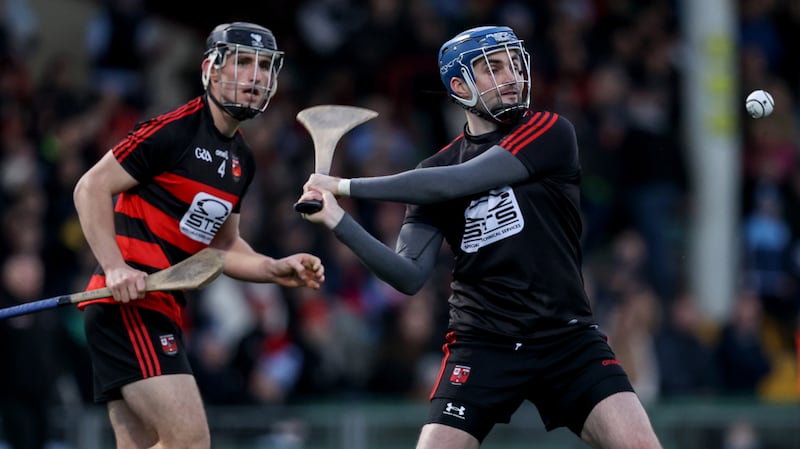The recent trial handpass rule in hurling led to players favouring a stick pass over a handpass.
The ratio of stick passes to handpasses was 8.0 – for every handpass there were eight stick passes. In the 2023 All-Ireland senior hurling championship, for every handpass there were 1.5 stick passes.
It is the standout finding from the comprehensive report compiled by Gaelic Stats, on behalf of the GAA’s Standing Committee on Playing Rules, after examining the experimental rules which were road-tested in third level matches.
There were two experimental rules showcased during the Higher Education’s Freshers Division One Hurling Leagues late last year.
1: A puckout had to travel beyond the near 45m line before it could be played by another player on the defending team. Penalty – A throw-in on the defender’s 20m line in front of the scoring space.
2: Redefining the handpass, players had three options: play the sliotar away with the opposite hand to that holding the ball; play the sliotar away with the original ball-holding hand after bouncing it off the hurley; play the sliotar away with the opposite hand after bouncing it off the hurley. Penalty – free from where the foul occurred.
Gaelic Stats, one of the foremost sports data companies analysing Gaelic games, collated information from a total of nine games between October and December. One of the distinct trends to emerge was a tendency for players to opt for a stick pass over a handpass – there was an average per game of 170 stick passes and 21 handpasses.
The report suggests the ratio of stick passes to handpasses “was clearly as a result of the new rule which was implemented as players did not want a foul against them for the incorrect technique on a handpass”.

Short stick passes were more prevalent in situations where in recent years you would expect to see a handpass.
However, there is a caveat with the analysis in the fact comparing Freshers hurling and the senior intercounty game clearly has its limitations. Apart from everything else, college fixtures are 60 minutes in length compared to 70 minutes for senior intercounty matches.
But as there are no relevant statistics on Freshers hurling, Gaelic Stats used information from their intercounty database of 187 games between 2016-2023 for comparison.
Over the course of the analysis, 190 handpasses with the correct technique were recorded and 88 per cent of those were successfully retained by the team in possession. In the 2023 All-Ireland SHC, 95 per cent of handpasses were retained.
There were also 25 fouls conceded by players deemed to have thrown the ball when attempting a handpass during the trial matches, while analysts spotted a further seven ‘fouls’ which were not awarded. Combined, it indicates 15 per cent (32 of 215) handpasses were deemed to be fouls.
There was a 71 per cent success rate from over 1,580 stick passes, where possession was retained by the team striking the ball. During the 2023 All-Ireland SHC, 67 per cent of all stick passes were retained by the team in possession.

On the basis of those findings, particularly the ratio of handpasses to stick passes, there does appear to be a case for further trialling of the handpass experiment as it encourages a greater use of the hurley.
However, the question remains as to whether the problems around the handpass in hurling are sufficiently impactful to justify such a fundamental change to playing the game.
On the puckout experiment, which required the sliotar to be struck beyond the 45-metre line, of 483 restarts analysed 98 per cent cleared that threshold.
That is very much at odds with the trend of puckouts at intercounty level in recent years, where short clearances have become commonplace.
In the 2016 championship, 16 per cent of puckouts landed within the goalkeeper’s 45-metre line. During the 2023 championship, 29 per cent of puckouts went short inside the 45-metre line.
Of the 483 puckouts in the Freshers matches, 52 per cent were retained by the team in possession. In the 2023 championship, 67 per cent of puckouts were retained as there were more short restarts by goalkeepers.

By its very nature, a consequence of forcing goalkeepers to go long with puckouts is an increase in contests for possession around the middle third – and so it proved.
Some 78 per cent of puckouts were contested in the trial games, compared to 44 per cent in last year’s All-Ireland SHC. The scoring return from a team winning their own puckout was 69 scores from 326 contested restarts.
Another consequence of the requirement to hit puckouts long was the elimination of the one-two restart where the goalkeeper taps short to an unmarked defender, moves out from his goal to take a quick return pass, and then invariably strikes the ball down the field.
The ball was hit back to the goalkeeper only an average of 1.4 times per game during the trial matches (predominately during open play), compared to an average of 6.2 times per match in last year’s SHC.
The report is now with Central Council, who will determine what the next steps should be in relation to the data collected, whether to park the experiments or recommend further trialling of some rules, perhaps for later in 2024 or in the preseason competitions of early 2025.














